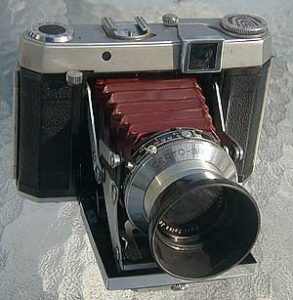Certo is nowhere near as well known as the cameras from Zeiss, Agfa, Voigtländer, even Balda… but this is one very excellent machine. Built in East Germany during the mid-1950s to about 1960?, it is a first class camera, usually excellent shutters – Synchro-Compur. Lenses tend to be f2.8/80mm Tessar. I’ve also seen them with f3.5/80mm Primotar. An alternate shutter is the East German “Tempor” shutter which seems to be a copy of the Prontor S family.
This camera has an awful lot going for it. I was impressed from the moment I first laid my hands on one about 4 years ago. I was even more impressed when I had to strip one of these down to do the ubiquitous repair that this camera demands. The interior of the camera is extremely well made and engineered… I was so impressed that I chose “certo6” as my eBay ID! So what are the good points on this camera?
- Coupled rangefinder and the only folder whose rangefinder is parallax corrected
- Film advance via 2 stroke frame advance lever… rather than the ubiquitous wind knob!
- Auto frame counter / double exposure prevention
- Excellent solid construction
The camera does have one slight problem 50 years after it left the factory. EVERY CertoSix I have seen (or heard of) MUST have its rangefinder prism & mirror replaced. While the camera is superbly designed, the material used to silver the mirror/prism is now “kaput”. Once this flaw is repaired, you’ve got a really excellent high quality folder!!
Certo Six Instructions
While the majority of folders are rather straightforward affairs as far as loading, taking pictures, and rewinding are concerned, the Certo Six is a tad different and needs a few words of explanation for the novice or first time user. I have received more than one back from a customer who through lack of expertise and knowledge turned a perfectly good Certo Six into a parts camera. The following a short guide to the basics of this fine unique camera.
The first characteristic of note is that the Certo Six winds film like a “modern” camera, and in this case, from right to left via a wind lever as opposed to the ubiquitous round knob found on 99% of folders. Actually, the only other “classic” folder that uses a wind lever is the Dacora Royal, a competent, but much less expensive camera – and its forte is that winding also cocks the shutter. Something even the sophisticated Certo Six does not do. OK, on to the basics.
Loading: Is rather like all roll film cameras. First you put the 120 roll film in the film cradle and draw the film leader to the left across the film gate to the take-up spool. Then advance the film via the lever to where the film indexing arrows on the film backing line up with the white dot on the lower center of the film gate. Then you close the back and at the top right you will find the frame counter. Manually turn the dial so that the small pyramid is facing the red or green dot (about 10 o’clock). Then you just advance the take up lever till the frame counter is at “1.”
Now you are ready to take pictures, almost. You need to focus, cock the shutter, and then push the shutter release. Focusing is done via the lever that lies on the bottom of the folding bed … moving tit right to left – left to right focuses the entire lens / shutter assembly.
The Certo Six has a convenient focus scale on top center, but this is for reference only and not to be counted on to be “Perfectly” accurate… trust the rangefinder through the viewfinder and the dial will give you a close proximity to the actual distance. You are now ready to shoot… however, if the initial winding did not set the shutter release …it won’t “push” to the left, DO NOT FORCE IT!!!!! There is a small button on the back top rear which will disengage the shutter lock. Push this to the right, and the shutter will be ready to go. Right above this button is the cable release socket.
One other interesting feature of the Certo Six is the two folding legs on the back. These “legs” allow the camera to sit flat when the front is opened.
Other than these aforementioned special notes, the Certo Six operates like other folders. Just treat this 52 year old classic with care, never force anything, and it will reward you with superb pictures and lots of fun and involvement that a modern “PHD” (push-here-dummy) camera just can’t match!



